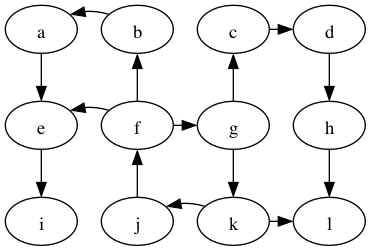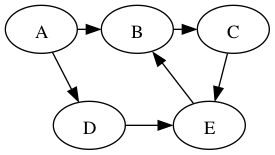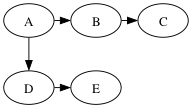CSCI C343 Data Structures Spring 2024
Lecture: Graphs and Breadth-first Search
The standard mathematical way to represent a graph G is with a set of vertices V and a set of edges E, that is, G = (V,E).
In a directed graph, each edge is a pair of vertices where the first vertex is called the source and the second is the target.
In an undirected graph, each edge is a set containing two distinct vertices.
I often use n for the number of vertices and m for the number of edges.
The following is an example of a directed graph.

The set of vertices for this graph is
{0,1,2,3,4,5}.
The set of edges is
{(0,0), (1,2),(1,4), (2,5), (3,5),(3,0), (4,2), (5,4), }.
The following is an undirected graph.

The set of vertices is {0,1,2,3,4}.
The set of edges is { {1,2},{1,0}, {2,3},{2,4},{2,0}, {3,4}, {4,0} }.
We often writes an undirected edge as (1,2) or 1-2 instead of {1,2}.
Adjacency List
The Adjacency List representation of a graph is an array of linked lists.
Example: for the above directed graph the adjacency list representation is
|0| -> 0
|1| -> 2 -> 4
|2| -> 5
|3| -> 0 -> 5
|4| -> 2
|5| -> 4
Example: for the above undirected graph the adjacency list representation is
|0| -> 1 -> 2 -> 4
|1| -> 0 -> 2
|2| -> 1 -> 4 -> 3 -> 0
|3| -> 2 -> 4
|4| -> 0 -> 3 -> 2
(Each edge is stored twice.)
Adjacency lists are good for storing sparse graphs.
- Space: O(n + m).
- Edge detection given two vertices: O(n)
- Edge insert: O(1)
- Edge removal given two vertices: O(n)
- Edge remove given edge handle: O(1) if use double linked
- Edge removal: O(n) or O(1) if use double linked and edge handle
- Vertex insert: amortized O(1)
- Vertex delete: not easily supported
Adjacency Matrix
The Adjacency Matrix representation of a graph is a Boolean matrix.
Example, for the directed graph above.
0 1 2 3 4 5
0 1 0 0 0 0 0
1 0 0 1 0 1 0
2 0 0 0 0 0 1
3 1 0 0 0 0 1
4 0 0 1 0 0 0
5 0 0 0 0 1 0
Example, for the undirected graph above.
0 1 2 3 4
0 0 1 1 0 1
1 1 0 1 0 0
2 1 1 0 1 1
3 0 0 1 0 1
4 1 0 1 1 0
Note that the matrix is symmetric.
Adjacency matrices are good for dense graphs.
- Space: O(n²)
- Edge detection given two vertices: O(1)
- Edge insert: O(1)
- Edge removal given two vertices: O(1)
- Edge remove given edge handle: O(1)
- Edge removal: O(1)
- Vertex insert: amortized O(n)
- Vertex delete: not easily supported
How could we represent Adjacency Matrices in Java?
Breadth-First Search
Def. a path is a sequence of edges such that the target of each edge matches the source of the next edge in the sequence. We sometimes abbreviate a path to v₀ ⇒ vₖ, where v₀ is the source of the first edge and vₖ is the target of the last edge. We write v₀ ⇒ᵏ vₖ when the length of the path is important. Also, when talking about multiple different paths, we might use a subscript to give the path a name, such as v₀) ⇒ₓ vₖ.
Problem: compute the shortest paths from vertex g to all other vertices in the graph.

Example: what is a shortest path from g to f?
Possible solution: g → k → j → f, length 3.
To prove this is really the shortest, we need to make sure there are no paths of length less-than 3 from g to f.
How do we prove that? Well, look at all paths of length less-than 3 that start from g.
Length 0 paths:
g
Length 1 paths:
g → c
g → k
Length 2 paths:
g → c → d
g → k → l
g → k → j
Good, none of the paths from g with length less-than 3 reach f.
So indeed, g → k → j → f is the shortest path from g to f.
BFS Algorithm
Towards a general algorithm for BFS, can we compute all the k+1 length shortests paths given all the k-length shortest paths?
Draw a picture of the wave-front of the k-length shortest paths and the out-edges on the wave-front.
High-level Algorithm:
for k = 0...n
for each path s ⇒ᵏ u:
for each edge {u,v} incident to u:
If we don't already have a shortest-path to v,
then s ⇒ᵏ⁺¹ u is a shortest path from s to v.
What data structures should we use?
-
The shortest paths form a tree: for each vertex v, store the previous vertex u in its shortest path. we call u the “parent” of v because u is the parent of v in the tree of shortest paths. This is also called the breadth-first tree.
-
For the paths of length k: We just need the end vertex of each path, so let’s maintain a bag of the vertices at the ends of the paths of length k.
-
To make sure we ignore vertices that have already been encountered, we use an array called
donethat maps vertex numbers to True/False.
Version 1 of the algorithm
static <V> void
bfs_v1(Graph<V> G, V start, Map<V,Boolean> visited, Map<V,V> parent) {
for (V v : G.vertices())
visited.put(v, false);
int k = 0;
ArrayList<V> ends = new ArrayList<V>();
ends.add(start);
parent.put(start, start);
visited.put(start, true);
while (k != G.num_vertices()) {
ArrayList<V> new_ends = new ArrayList<V>();
for (V u : ends)
for (V v : G.adjacent(u))
if (! visited.get(v)) {
parent.put(v, u);
new_ends.add(v);
visited.put(v, true);
}
ends = new_ends;
++k;
}
}
Some observations about version 1
-
If the
new_endsis empty at the end of the loop body, then we can stop early. -
The
endsandnew_endscan be combined into a single data structure if we use a queue instead of two bags.The front part of the queue represents
endsand the back part of the queue representsnew_ends.With this change, we can simplify the code by combining the
while kand thefor uloops into a single loop that checks whether the queue is non-empty.
Final version of breadth-first search
static <V> void
bfs(Graph<V> G, V start, Map<V,Boolean> visited, Map<V,V> parent) {
for (V v : G.vertices())
visited.put(v, false);
Queue<V> Q = new LinkedList<V>();
Q.add(start);
parent.put(start, start);
visited.put(start, true);
while (! Q.isEmpty()) {
V u = Q.remove();
for (V v : G.adjacent(u))
if (! visited.get(v)) {
parent.put(v, u);
Q.add(v);
visited.put(v, true);
}
}
}
Student group work
Example run of BFS version 2

queue parents
[A] P[A] = A
[B,D] P[B] = A, P[D] = A
[D,C] P[C] = B
[C,E] P[E] = D
[E]
[]

Time complexity of BFS
- Main loop: we traverse the entire adjacency list graph once and the combined length of the adjacency lists is O(m), so we have O(m) for the main loop.
- Initialization: O(n) time and space for the parent and done arrays.
- Total: O(n + m)